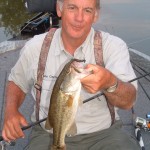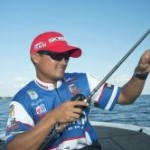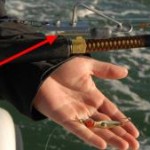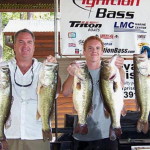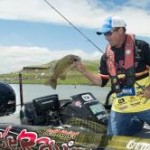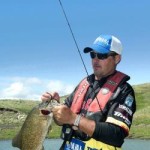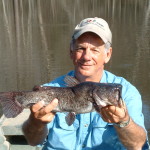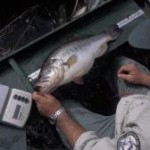
Biologists study fish caught electrofishing
A “Shocking Way to View Fish”
Editor’s Note: The following is from The Florida Fish Busters Bulletin, a service of The Florida Fish & Wildlife Commission written monthly by Bob Wattendorf.
An electrifying way to study fish
Not everyone can step up to the bow of a boat, lean against the railing, step on a pedal and start netting fish as they float up to the surface. However, biologists use various styles of electrofishing boats or backpack shockers to collect fish for scientific analyses and to help manage the fishery.
Florida Fish and Wildlife Conservation Commission (FWC) fishery biologists have college educations and special training to operate this equipment safely. For some professionals, it is one of the more enjoyable perquisites of the job. Just to be clear, it is illegal for any angler to fish with electricity. Only fishery biologists can use this method when conducting scientific sampling.
Electrofishing boats use a generator to create an electric current to shock fish in a way that temporarily stuns them. The current flows out in an electrical field between booms that hang off the front of the boat and the metal hull of the boat itself. The electric field does not kill the fish but can actually attract them toward the booms, before temporarily stunning those that swim within 6 to 8 feet. Biologists then scoop up the fish in knotless nets and place them in an aerated live well to recover.
The electricity’s effects on the fish are typically minimal. Several factors contribute to how long the fish remains stunned, including the size of the fish, the species, water temperature and conductivity, how close the fish is to the booms and how long the current is applied. In most cases, stunning occurs within a few seconds of the fish entering the electric field and lasts less than a couple minutes once the fish is removed from the electric field.
Biologists typically identify the fish by species, count and measure them, including their length and weight. Depending on the study, blood samples may be taken, stomach contents examined and tissue samples collected to determine mercury and pesticide levels, or the fish’s genetic makeup. Occasionally biologists transport some specimens to the lab or hatchery for further examination or for breeding purposes. Scientists may also harvest a few to examine their otoliths, or earbones, which, once cut and ground into thin slices, show growth rings that reveal their age.
In the field, biologists also collect data that can be used in conjunction with the fish data to evaluate the fishery and determine how best to manage the resource. For instance, they record water clarity, conductivity, dissolved oxygen and temperature, along with other information about the type of plants, specific location and substrate (for example, mud, gravel or sand). This is useful to determine why certain fish may be present or absent and to compare samples from year to year or with different water bodies.
Electrofishing can be much less damaging than methods that entangle or trap fish, such as seines, gillnets, wire traps or trawls, which may injure or kill them. It is an urban myth that electrofishing harms the eggs of female fish. In fact, biologists use electrofishing to collect brood fish to take to hatcheries to use as parent fish.
Electrofishing is one of the main tools that Florida’s fish biologists use to determine how healthy the fish population is in a particular pond, lake, river or canal. They then use that information to try to ensure the fish and their habitats are taken care of and to make fishing more enjoyable. For instance, it can help determine if specific habitat restoration efforts, stocking programs or conservation measures were successful or if measures are needed to enhance angler enjoyment.
Information from electrofishing and other sampling methods, including angler creel surveys – where we talk to anglers to determine what they caught – provide much of the information that we use in writing our quarterly fishing sites and forecast reports. Those reports, along with interviews with fishing guides and annual predictions for anglers of top fishing destinations for bass, bream, striper and catfish, are available at MyFWC.com/Fishing; select “Freshwater Fishing” then “Sites & Forecasts.”
Students at the Florida Youth Conservation Network learning about electrofishing.
Fisheries biology is a fun possibility for a career, for those who like science, nature and the outdoors. As part of the FWC effort to create the Next Generation that cares and to help sustain fisheries resources for the public, the FWC has created the Florida Youth Conservation Center Network (FYCCN.org).
A major part of the FYCCN effort goes toward hosting fish camps each summer around the state. The goal of Fishing and Basic Boating Skills Camps is to create life-long anglers and stewards of aquatic and fisheries resources. Licensed anglers and hunters, who choose to donate for youth fishing and hunting education programs when they buy their licenses, help fund these camps. Over the past four years, these camps have expanded from two to 15 locations across the state with a potential to reach 900 children. Besides being fun and informative camps help teach kids angling and boating skills, and introduce them to conservation stewardship and the possibilities of a future career.
A recently produced video highlights for camp participants how scientists use electrofishing. It provides information about common freshwater fishes and angler recognition programs. To see the video yourself, check out “A shocking way to view fish” on the FWC video channel at YouTube.com (http://bit.ly/YT-shock).
